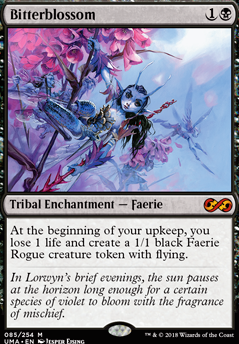Liliana, the Last Hope
has entered the list, replacing the archetypal favourite
Liliana of the Veil
. From the birth of this list, I was running a 1-of Veil, but it always felt stronger in the list when I was still running Ancestral Visions. Now that I'm running a more tempo-focused list with Opt, I found the Veil's +1 hurt me just as much as my opponent, and that her -2 just made her my second most expensive removal spell. In short, I found less reason to cast her unless I was already winning or had a hand full of lands. Last Hope functions as weenie removal, perfect for the mirror, Linger Souls tokens, etc. Her -2 feels much better for me, as she can recycle all of my creatures for reasonable amounts of value.
Mistbind Clique
is a wonderful card. It's one of the strongest creatures in the archetype, as a 4 mana 4/4, but of course, it doesn't end there. With the ability to champion a Faerie, you can trade in a tapped token, or a Bitterblossom that it about to kill you to get a 4/4 that TAPS YOUR OPPONENT'S LANDS. And of course, Champion doesn't target, so if your opponent wants to respond to the Champion trigger, they need to wipe all your Faeries (including Bitterblossom) off the board to keep you from having this monstrous creature.
Jace, the Mind Sculptor
is the newest threat to enter the list, and fits almost too well into a control strategy. Fatesealing someone can prove to be strong, as you can lock your opponent out of seeing their threats as best you can, but this can easily be broken by simply cracking a fetchland.
His ultimate is what wins the game, and while we want to win through attrition, Jace feels like a win-more card. However, when added to the board, his presence can either help turn a poor board state around by brainstorming, or solidify a strong board state, making our attrition win all the more guaranteed.

